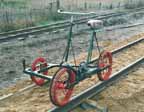October 06, 2005
Train

urban structure for aesthetic urban transportation
Underlying Train, by Helen Evans and Heiko Hansen, is the critical role of traffic and its industry for our society. Traffic has an impact for everybody; locally or remotely. The transportation industry and its economic power have a direct effect on pollution, large-scale urban planning schemes, political decision-making and the distribution of wealth. On a more semantic level, the car industry has successfully blurred the boundary between real functional needs and transportation dreams made possible through the acquisition of automobile artifacts. On the other hand many big research programmes seeking for alternative forms of public transport, for example Personal Rapid Transit systems carried out internationally could in most cases not offer a viable solution[1]. French sociologist, Bruno Latour reflected on the failure of France's most ambitious attempt to develop a working Personal Rapid Transit system and published the work as 'Aramis. Or, the Love of Technology'.
Between urbanism, vehicle design and automation the project Train is a research into the aesthetics of movement and travel. To locate the work we are using real, existing past, present and future, abandoned or at times unused railroad transportation systems; in Paris the railway track 'La Petite Ceinture'[2], which stopped its service in 1934 and the new tramway, which is partly completed. Both transportation systems are encompassing the city centre of Paris and are running parallel to the main traffic artery of Paris, the Periphérique, which is the circular city motorway that defines Paris and its Banlieu (the suburbs). It is this discrete line that splits the city into inside and outside. The Periphérique itself is pure automobile infrastructure and at peak times the traffic moves at walking speed.
Using existing, past and future railway transportation systems and Reverse Cultural Engineer them. Technological process feathers at its periphery. Similar to a fractal image an innovation is followed by other innovations, based on the original one. In a recursive environment like this we would like to go back to the origin, the innovation of railway and propose a different solution, here an individual perpetuated vehicle. In this way artistic process starts by going backwards to propose utilitarian design scenarios.
The Train project is a speculation into the language and aesthetics of transportation, particularly those that have become so ubiquitous and unquestionable for us. By proposing different real installations which would work within active or abandoned public transport structures and a series of conceptual designs a dialogue should be raised that engages in questions about the reality and "real fiction" of traffic.
Posted by jo at October 6, 2005 11:45 AM
